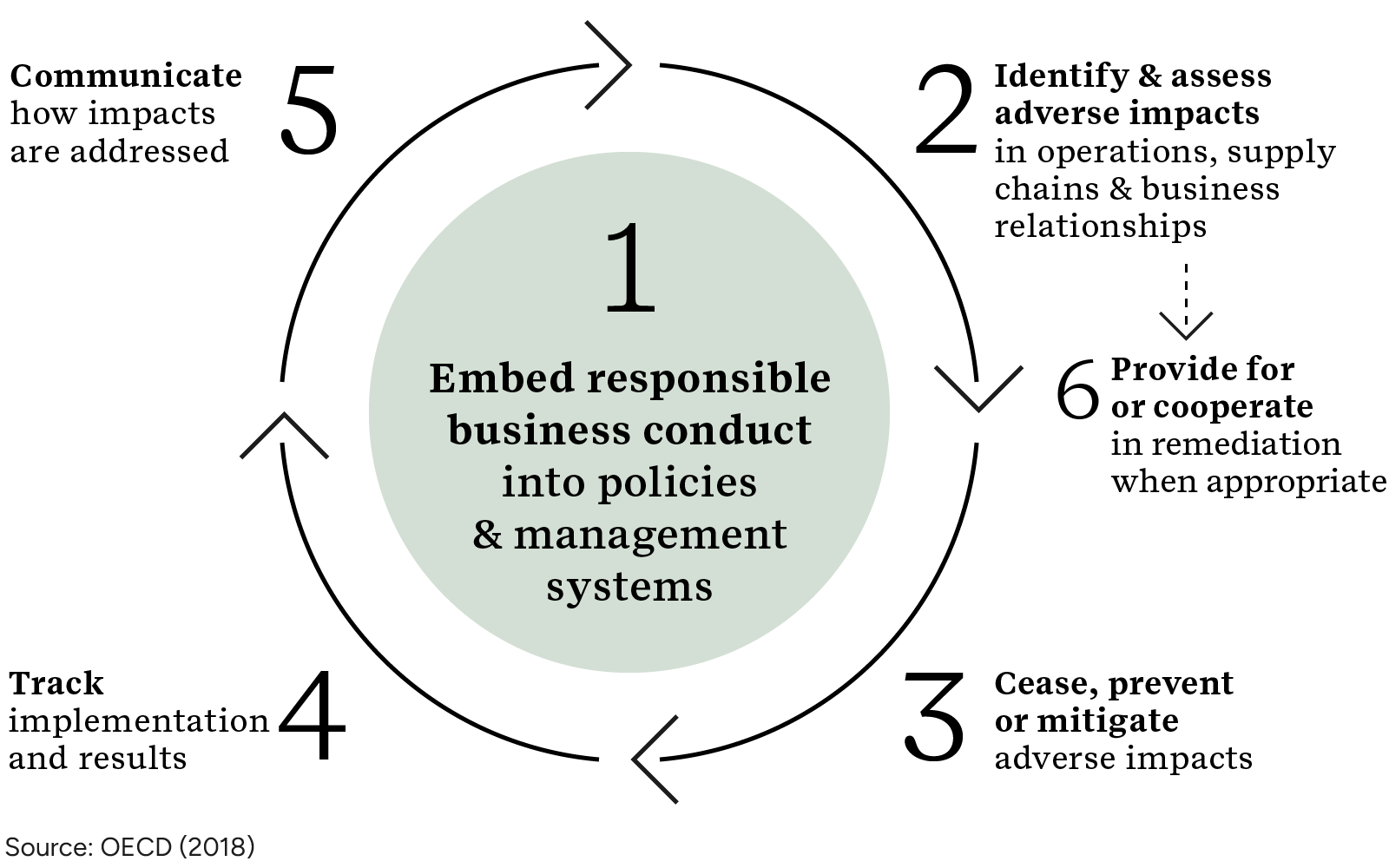Many companies have made significant progress on human rights over the last decade, using the 2011 UN Guiding Principles on Business & Human Rights as the global authoritative guide. More recently, a raft of new frameworks and regulations, such as the 2023 update to the OECD Guidelines for Multinational Enterprises on Responsible Business Conduct, the 2022 German Act on Corporate Due Diligence Obligation in Supply Chains, and the EU’s proposed Corporate Sustainability Due Diligence Directive (CSDDD), have extended to environmental issues the concept of “due diligence” originally formulated for human rights.
Today, risk-based due diligence requires companies to identify, address and account for potential adverse impacts on people and the planet and to communicate how they are doing this to stakeholders. The OECD outlines this process below:

Many companies are already well versed in specific aspects of environmental risk management and human rights due diligence. However, these frameworks, alongside the landmark recognition by the UN of the human right to a clean, healthy, and sustainable environment, are driving the need for a more integrated approach to address both issues throughout organizations’ operations and value chains.
In terms of practical implementation, here are five key actions businesses can take to integrate these environmental and human rights due diligence requirements into their business:
1. Engage with rights-holders and stakeholders
Most companies that need to comply with environmental laws already have established environmental risk management systems in place. However, companies also need to consider how to apply these management processes through a human rights lens.
This means consulting with potentially affected groups or proxies (such as non- governmental organizations or credible workers’ organizations) to identify whether potential impacts on the physical environment- such as pollution resulting from emissions to air or discharges to water, even if compliant with regulations – may result in impacts on people.
Engaging means communicating with stakeholders on the company’s environmental performance, together with information on how measures to protect the environment are also actively preventing impacts on community health or livelihoods.
Specifically, ensuring that children and young people are included in consultations is gaining special attention, with a recent UN committee general comment on children’s rights and the environment explicitly referencing a child’s right to be heard.
2. Ask how environmental targets and strategies are impacting people
Shareholders and stakeholders are applying pressure on companies to step up and deliver against ambitious greenhouse gas (GHG) emissions and environmental impact reduction targets. In many cases, this has resulted in business leaders having specific sustainability KPIs tied to the milestones and outcomes needed to secure meaningful reductions in scope 1, 2 and 3 GHG emissions and other environmental impacts. However, these performance requirements and their associated strategies still often overlook human rights issues.
To incorporate human rights effectively, climate and other environmental strategies need to consider the potential positive and negative impacts on people from inception, and C-suite positions should include people and human rights-related due diligence KPIs as well.
3. Access cross-functional expertise
To meet the full need for due diligence, companies must understand the human rights implications arising from their potential environmental impacts.
In practice, this means that environmental experts working on company performance related to water, waste, GHG emissions, recycling, or biodiversity, need to collaborate with specialists on the related human rights impacts, whether to health or livelihoods.
This convergence of environmental and human rights expertise also needs to exist at the board level. While companies may appoint climate experts to their executive teams and committees, the same needs to apply for human rights to ensure that environmental and human rights approaches are joined up, both at the strategic and operational level.
Supply chains already pose significant human rights and environmental challenges, and these are intensifying due to rising geopolitical tensions, cost of living, and demand for raw materials.
Companies can exercise integrated supply chain due diligence by overlapping environmental and human rights country risk assessments to identify combined risk hotspots that require closer examination and targeted intervention.
Also, while many companies are already adding ESG topics to suppliers’ codes of conduct, longer checklists do not automatically mean suppliers will understand and address potential environmental and human rights issues effectively in an integrated way. To support suppliers, companies need to ensure that simple training materials with industry-relevant examples reach the relevant teams within supplier organizations or provide targeted training to high-risk suppliers and ensure appropriate monitoring mechanisms are in place.
5. Expand grievance and remedy mechanisms
The European Parliament, European Commission and European Council, in the development of the forthcoming CSDDD, have been united in stating that failure to include an adequate company-level grievance mechanism will result in sanctions for companies.
Company grievance mechanisms therefore need to have the capacity to address human rights impacts arising from environmental harms. For example, this includes recognising that causation or attribution of health impacts to a specific business practice may not be straightforward and that an illness or disease may take a long time to manifest. Organizations should be aware that new guidance from the UN Development Program, currently under public consultation, recommends extending the timeframe allowance for a grievance to reflect the potential for long-term evolution of illnesses and diseases.
Human rights and environmental due diligence go hand in hand. Companies need to understand the linkages between these two aspects and adopt an integrated approach to effectively avoid harm and support remediation throughout their operations and value chain. By taking a more comprehensive approach to due diligence, companies can ensure they fulfil both their human rights and environmental commitments, while supporting a just transition to a low carbon economy.
Author contacts
Alexandra Guaqueta, Global Leader, Social Performance & Human Rights
Alexandra.Guaqueta@erm.com
Marina d'Engelbronner, Partner Lead, EMEA
Marina.DEngelbronner@erm.com
Désirée Abrahams, Human Rights Consulting Director, EMEA
Desiree.Abrahams@erm.com

